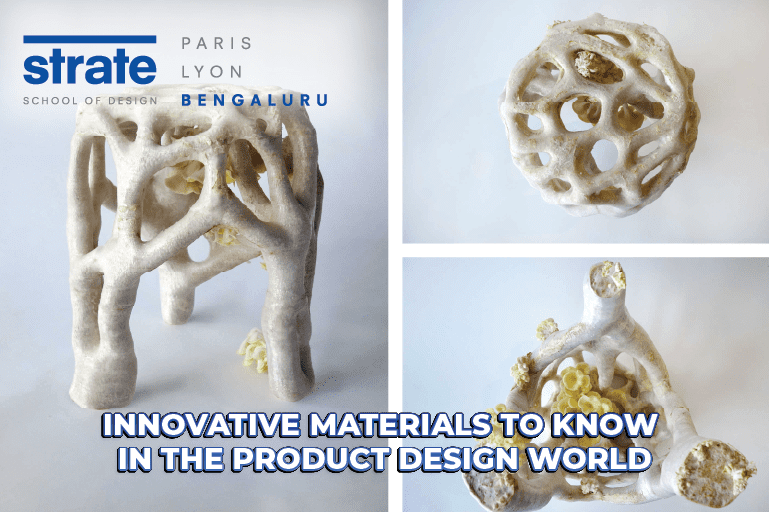We are living in the era of smart materials and tech-powered innovation in material design. Think of vegan leather, furniture made from mushrooms, lab-grown silk textiles, and self-healing paint on the walls. The ongoing technology innovations across sectors are fuelling a demand for novel materials. These materials are focused on being lightweight, sustainable, smart-engineered, have advanced composites, superior properties, nano-formulation, and more.
As AI becomes part of our everyday lives, data analytics is empowering researchers and innovators to develop new novel materials. These new products are user-centric, intuitive, accessible, and ergonomically designed and some even have interactive elements etched into them for enhanced user experiences. New material innovations are empowering product designers to visualize disruptive product developments and appeal to users’ sensory experiences.
The new material developments allow designers to explore from a human-centric design approach. Focused on circular design where product designers consider how consumers can dispose of a product post-use. The innovation in materials in this regard acts as a driving force for designers to think, re-think, and innovate with tech integration and sustainability first approach. Improving a user’s quality of experiences both in tangible form and sensory appeal.
Leading game-changing materials to watch out for in 2024
Yanko Design shares some of the latest innovations in materials that product designers must keep an eye out for. Here are a few of the leading material innovations featured by Yanko Design that are changing the product design industry:
1. Graphene
Graphene is already known for its use in producing thermos regulating fabrics however this material has become an absolute hit across sectors like construction, smart tablets, phones, and more. Graphene is one atom thicker than steel and is still stronger than the latter. It’s fast changing the world we know offering smartphone materials the ability to bend without breaking. In construction it allows buildings to resist and withstand earthquakes.
What makes it unique?
This material has excellent conductivity that can revolutionize solar panels and make them more accessible. In clothing, it can monitor a person’s health and even charge devices on the go. It’s a versatile material paving the way for new product innovation and disruption we can’t wait to see.
2. Advanced ceramics
In our tech-driven world, a new material innovation that cools down the running and churning engines will be a game-changer. Advanced ceramics is on its way to becoming the game-changing material that global giant Apple is already experimenting with, calling it Ceramic Shield Technology.
When machinery is equipped with ceramic components, it resists heat and wear and offers scratch-resistant screen properties. A critical disruption for many smartphone brands. Its durability is unmatched compared to existing products. Advanced Ceramics is on its way to becoming a popular choice as sustainability becomes mainstream across processes.
What makes it unique?
It’s shatter-proof and has a unique strength-to-weight ratio along with thermal stability. It can also conduct or resist electricity which essentially makes it the biggest disruption in manufacturing processes.
3. Mycelium
Mushrooms are already known for their leather-like property that is revolutionizing the vegan leather industry. However, innovators and scientists have dug deeper under the mushroom plants to find the material Mycelium. It is considered often as the body of the mushroom and it’s at times a hundred times larger than the oyster or button-shaped tiny mushroom that grows from the ground up.
Mycelium offers designers incredible benefits and different use cases. One of the most game-changing is its ability to replace Styrofoam and other mouldable materials. There is already a revolutionary innovation using mycelium – a single-use biodegradable grill. A true product design innovation that has shaken the global design community and gotten their attention to Mycelium.
What makes it unique?
It’s a naturally growing material that is eco-friendly and has the inherent nature of being biodegradable. It has self-healing and re-growing abilities at a fast pace. What makes it truly unique is that it’s a fungus-based material. One that grows from ingesting natural waste, which is a need of the hour and a win-win for designers.
4. Self-healing materials
Imagine a material that can help building cracks heal themselves, safeguarding your home against all odds. Imagine the same material can be used to design unique furniture, types of equipment, and handy materials.
This self-healing material means one that can ‘mend’ itself over some time. A material with property to reverse any damage caused to them. These materials are often mixed with other specific elements like fibres or capsules into a say, concrete mix that contains repairing solutions. Self-healing materials are also part of paints and coating which allow scratches on automobiles to disappear when exposed to UV light or natural light.
Many improvements are already in process in this regard in the category of self-healing polymers and glasses that allow for self-healing properties in tech damage as well (like smartphones and tablets).
What makes it unique?
In a possible use-case scenario, let’s imagine if you drop your phone and can see the material heal itself. Can you visualize the scratch or crack healing and disappearing over a said period? If this is not enough, it also helps to heal cracks and signs of wear and tear in buildings. Increasing the longevity of the construction and structures and your tech products. Saving you your hard-earned money.
Think of the possibilities for product designers to use self-healing materials to innovate our daily use products and furniture. Revolutionary and game-changer material for designers, right?
5. Bioplastics and Biocomposites
Giving tough competition to petroleum-based plastic materials, Bioplastics, and Biocomposites are naturally derived polymers that integrate natural composites into them.
Bioplastics are derived from corn or hemp, which are naturally occurring materials.
Biocomposites are derived using natural filler materials and natural binders (glue) to create an alternative to plastic that is stiff, durable, and resistant to many elements in the environment.
A common biocomposite used is coffee waste made from coffee grounds that is mixed with natural binding agents. Creating a new material that has similar properties to plastic with the advantage of being eco-friendly and biodegradable.
What makes it unique?
Bioplastics and Biocomposites have the advantage of being biocompatible and degradable. They are the main ingredient in making nature-friendly materials while reducing waste. Helping designers to work with a material that aids in solving the waste management issue of modern history. They are easy to make and access, making them a popular choice for product designers to do their R&D.
Other leading advancements in material innovation include Liquid Metal Alloys and Transparent Solar Panel. Liquid Metal Alloy has the properties to transform smart wear design, medical devices, responsive prosthetics, aerospace components, and more. Making our gadgets sleeker, optimized, and overall enhancing their performance. Transparent Solar Panels hold immense potential to capture UV and near-infrared energy to enable power generation. They are thin, efficient, and tiny – apt for versatile use across sectors. Like, imagine a panel being able to charge your EV while you step out for lunch for an hour.
These material innovations are radically transforming product design developments. Demanding product designers to be more collaborative and explorative with new materials. A leading number of start-ups and research organizations are hiring skilled product designers as part of their R&D team to develop disruptive products. Product Design today is a fine integration of design and technology with sustainability and carbon footprint neutrality at the forefront.
Strate School of Design offers a global learning programme in Product Design. The programme pedagogy focuses on designing for the people and the planet with technology-driven solutions. The school empowers students with industry-aligned learning practices that include regular integration of live projects and internships. The global exposure to Starte Lyon and Strate Paris brings in international networking and semester exchange opportunities to students.
Learn more about the Product Design programme at Strate here.



Want to Become a Designer ?
Strate is a unique design school that nurtures your talents as a designer by offering state-of-the art designing courses in Bangalore.
Join Strate